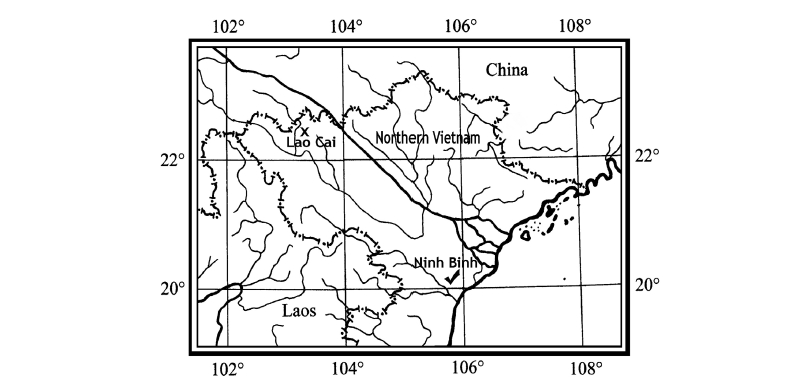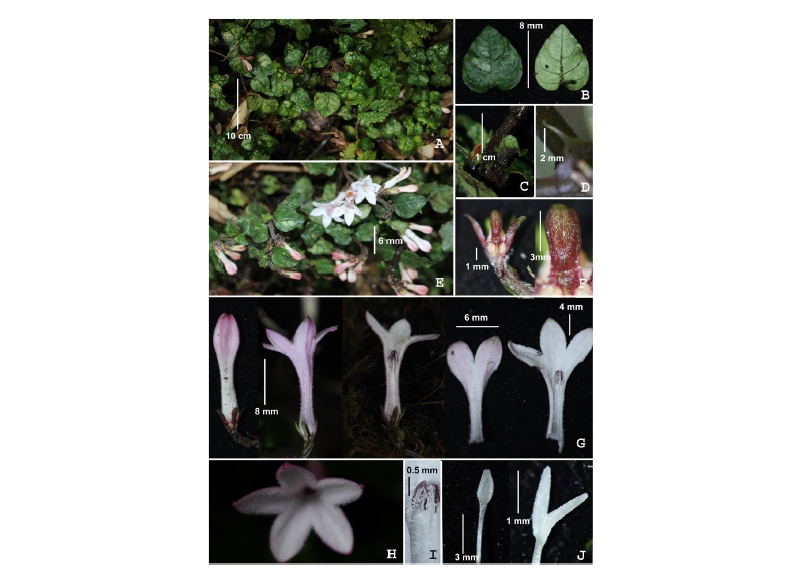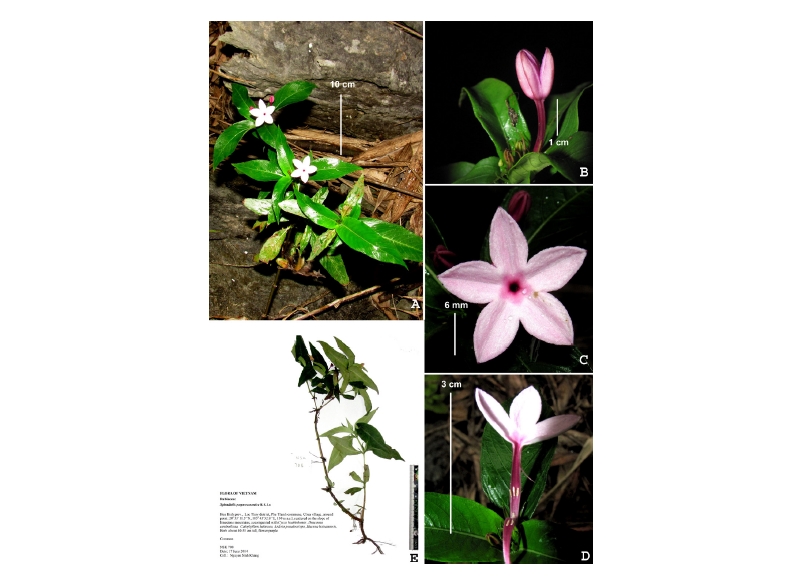Introduction
The genus Spiradiclis Blume belongs to the tribe Ophiorrhizeae in the subfamily Rubioideae of the family Rubiaceae (Bremekamp, 1952; Bremer and Manen, 2000). It comprises about 47 species and is distributed in tropical and subtropical regions of Asia (Chen and Taylor, 2011; Wang et al., 2015; POWO, 2018). In Vietnam, the genus was hitherto represented by only two species, Spiradiclis leptobotrya (Drake) Pit. and S. caespitosa Blume (Pitard, 1923; Merrill, 1942; Pham, 2000). During our field investigations in Lao Cai and Ninh Binh Provinces of Vietnam during 2002, 2016, and 2017, we collected two interesting specimens of Spiradiclis (Fig. 1), which after critical morphological examination and consulting the relevant literature and type specimens (Pitard, 1923; Merrill, 1942; Pham, 2000; Ninh, 2005; Chen and Taylor, 2011; Pan et al., 2016) identified as S. hainanensis H.S. Lo, and S. purpureocaerulea H.S. Lo. These species were hitherto known only from China but never from Vietnam. A detailed description and color photographs are provided for the newly recorded species.
Materials and Methods
All the specimens of Spiradiclis housed in important Vietnamese herbaria such as HN, VNM etc. were critically examined using light microscope. Photographs of the type specimens housed in the virtual herbaria (IBSC, IBK K, L, NY, and P) were also studied. Morphological characters were studied consulting the relevant literature (Pitard, 1923; Merrill, 1942; Pham, 2000; Ninh, 2005; Chen and Taylor; 2011; Pan et al., 2016).
Results
Taxonomic treatment
Key to Spiradiclis species in Vietnam
1. Inflorescences cymose, unbranched 2- or 4-flowered
2. Calyx densely villosulous to glabrescent, hypanthium, ca. 1.5 mm; lobes 1.2 - 1.5 mm..........S. hainanensis
2. Calyx pubescent; hypanthium, ca. 2 mm; lobes, 4 - 4.5 mm, acuminate..........S. purpureocaerulea
1. Inflorescences cymose, dichasially branched many flowered
3. Leaf blade elliptic to elliptic-ovate, 1 - 6.5 × 1 - 3 cm; secondary veins 3 - 7 pairs.
Inflorescence cymose, puberulent to strigillose, unbranched or dichasially branched one time..........S. caespitosa
3. Leaf blade elliptic, 4 - 15 × 2 - 3 cm; secondary veins 8 - 12 pairs. Inflorescences cymose, strigillose, unbranched or dichasially branched 5 - 6 times..........S. leptobotrya
Spiradiclis hainanensis H.S. Lo Acta Bot. Yunnan. 9: 301. (1987); C. Tao & C.M. Taylor In: Wu C.Y. & Raven P.H. (eds.). Fl. China, 19: 330-339 (2011). Type: China: Hainan: Ya Xian, Si-feng-shan. C.Wang 34588 (IBSC photo!).
Perennial herbs, 20 - 30 cm tall; stems densely villosulous, terete, rooting at nodes 5 - 8 mm long. Petiole 0.3 - 0.6 mm, densely villosulous; leaf blade thinly papery, adaxially greyish black, abaxially pale grey, cordiform-orbicular to ovate, 0.8 - 1.5 × 0.7 - 0.9 cm, both surfaces hispidulous at least on principal veins to glabrescent, base cordulate to subtruncate, apex obtuse; secondary veins 3 or 4 (- 5) pairs; stipules narrowly triangular, 1.5 - 2.5 mm glabrescent or glabrous. Inflorescences cymose, 2 - 3 (- 4) flowered, glabrescent, dichasial; peduncle 7 - 8 mm. Flowers subsessile. Calyx glabrescent or glabrous; hypanthium portion subglobose to oblanceoloid, 1 - 1.5 mm; lobes narrowly lanceolate, 3 - 5 × 1.5 - 2 mm. Corolla pinkish to white, salverform, abaxially pubescent, purple outside glabrous; tube ca. 8 - 10 mm; lobes 5, oval, 4 - 6 × 3 - 4 mm, Stamens 5; anthers eliptic-oblong, 1.5 - 2 mm long. Stigma lobes linear; ovary 2, ovules many. Long-styled flowers: stamens included; filaments adnate to the lower corolla tube, ca. 1.5 mm long; styles 6 - 8 mm long; stigma ca. 1.5 mm long, white, extended to corolla throat, not exserted. Short-styled flowers: stamens extended to corolla throat, not exserted; filaments adnate to upper corolla tube, ca. 0.3 mm long; styles ca. 6 mm long; stigmas 1 mm long, included. Capsules ellipsoid-ovoid, 2 - 3 mm in diam., with persistent calyx lobes, dehiscent septicidally and loculicidally; valves 4, ovate, 3 - 5 mm long. Seeds 8 - 10 per capsule, ca. 0.3 mm long, brown (Fig. 2).
Distribution: Vietnam: Lao Cai Province (Sa Pa, Bat Xat). China: Hainan (Sanya) and Yunnan
Ecology and habitat. Lowland broad-leaved evergreen forests.
Specimens examined: Vietnam, Lao Cai Province, Sa Pa Dist., (2500 - 2900 m. a.s.l.), 21th October 2016 B.H.Quang 230 (HN!), Bat Xat Dist., N 22º 24′ 28.5″E 103º 44′58.1″ (2547 m. a.s.l.), 6th July 2017 B.H.Quang 234 (HN!).
Spiradiclis purpureocaerulea H.S. Lo, Bull. Bot. Res., Harbin. 6(4): 39. (1986); C. Tao & C.M. Taylor In: Wu C.Y. & Raven P.H. (eds.). Fl. China, 19:330-339 (2011). Type: China: Guangxi: Longzhou, Shangjin, roadside, on limestone, 15thAug.1935. S.P.Ko 55507. (SCBI, Isotype– IBK photo!).
Perennial herbs, 10 - 15 cm tall; stems stout densely brown pubescent. Leaves subsessile; the blade drying papery, adaxially dark green, abaxially pale green, elliptic, obovate, 4 - 5 (- 8) × 1.5 - 3 (- 5) cm, adaxially densely strigose-hispidulous, abaxially densely pubescent to glabrescent, base rounded or obtuse, apex obtuse or acute; secondary veins 8 - 10 (- 12) pairs; stipules subulate, 1 - 3 mm, wide at base, pubescent, caudate-acuminate. Inflorescence a terminal cyme, 2 - 3 cm, densely pubescent; peduncles very short. Flowers subsessile purple. Calyx tubes ca. 2 mm, hypanthium portion obconic-globose, pubescent; lobes 6, as long as the tube, narrowly lanceolate, 4 - 4.5 mm, acuminate. Corolla purple-violet, slenderly salverform; tube 19 - 20 (- 25) mm; lobes 5 subovate, 7 - 9 × 4 - 6 mm, obtuse. Stamens 5; anthers linear-oblong, 2 - 1.2 mm long, linear. situated at the throat of the tube Stigma bilobed, lobes ovoid; ovary 2-celled, ovules many, axile. Long-styled flowers; stamens included; filaments adnate to the lower corolla tube, ca. 1 mm long; styles 2 - 3 mm long; stigma ca. 0.4 mm long, white, extended to corolla throat, not exserted. Short-styled flowers: stamens extended to corolla throat, not exserted; filaments adnate to upper corolla tube, ca. 0.2 mm long; style 1 - 3 mm long; stigma ca. 1 mm long, included. Capsules subglobose, 4 - 4.5 mm in diam., pubescent with persistent calyx lobes, ovate, 3 - 5 mm long, valves 4. Seeds 10 - 20 per capsule, ca. 0.6 mm long, brown (Fig. 3).
Phenology: Flowering in June; fruiting in August.
Distribution: VIETNAM: Ninh Binh Prov., Nho Quan Dist., Cuc Phuong Municipality, Cuc Phuong National Park, Dang locality, about 1 km WNW of Dang Forest Control point, N20º 16′ 28'', E105º 40′57''. Secondary closed evergreen seasonal broad-leaved lowland forest on limestone hills at elev. about 400 m a.s.l. CHINA: Guangxi.
Ecology and habitat. Terrestrial lowland broad-leaved evergreen forests on alluvial soils derived from limestone.
Specimens examined: Vietnam, Ninh Binh Province, Nho Quan District, Forest Control Point, N20º 16′28'', E105º 40′57'' on limestone hills at elev. about 400 m a.s.l., 17th June 2014, N.S.Khang 708 (HN!).
Conservation status: Spiradiclis hainanensis in Vietnam is known only from two populations growing in the primary broad-leaved evergreen closed forest at an elevation range of ca. 2500 - 2900 m a.s.l.). It was found associated with Acer, Magnolia, Photinia, Polyspora, Polystichum, Rhododendron, Rhodoleia, Schefflera, Schima, Strobilanthes, Utricularia, Vaccinium and Vittaria species. We observed 50 - 100 mature individuals in the field at two sites which are prone to habitat destruction due to the anthropogenic activities. Therefore, we propose this species to be designated under 'Vulnerable' category under criterion D2 (VU D2) (IUCN, 2016).
Despite of our continuous surveys and observations, we could find Spiradiclis purpureocaerulea only in a single locality in Vietnam. This was found growing on slopes, secondary closed evergreen seasonal broad-leaved lowland forest on limestone hills at an elevation of ca. 400 m a.s.l., in association with Acer, Actinidia, Altingia, Ardisia, Arisaema, Asplenium, Burmannia, Daphniphyllum, Euonymus, Impatiens, Lyonia, Magnolia, Oreocharis species. We could observe approximately ten individuals growing in the area, therefore, proposing a preliminary status of Vulnerable (VU) according to IUCN Red List criteria (IUCN, 2016).
Acknowledgments
Authors are grateful to the international cooperation mission with Russia, and supported by Vietnam Academy of Science and Technology (VAST) under grant number (Code Mission: QTRU01.09/19-20). This work was also supported by research fund of Chungnam National University. RKC is thankful to the Director, Agharkar Research Institute for promoting the research activities between Korea and Vietnam.
Authors Information
Joongku Lee, Chungnam National University, Professor, https://orcid.org/0000-0001-6250-3138
Nguyen Sinh Khang, Institute of Ecology and Biological Resources, Researcher, https://orcid.org/0000-0001-5171-4140
Ritesh Kumar Choudhary, Agharkar Research Institute, Researcher, https://orcid.org/0000-0001-6250-4624
Bui Hong Quang ,Institute of Ecology and Biological Resources, Researcher and Professor, https://orcid.org/0000-0001-6878-7514







